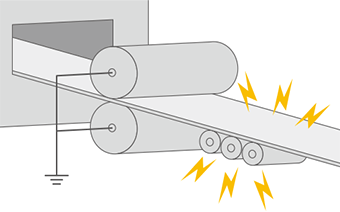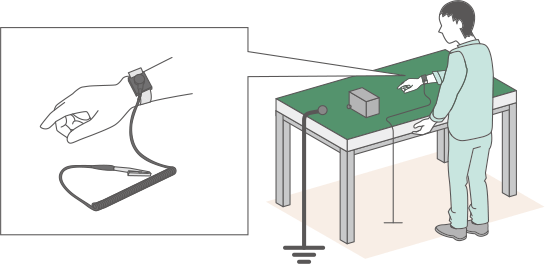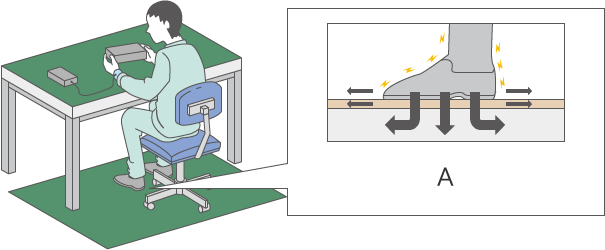Connecting to Ground
After detecting static electricity, countermeasures need to be taken. What should you do to eliminate static electricity that has been generated? In the case of a conductor such as metal, grounding is the most common way to deal with static electricity.
- Working principle of static elimination by grounding
- Example 1: Wrist strap
- Example 2: Anti-static floor materials
Working principle of static elimination by grounding
If the target is a conductor, simply grounding it will effectively eliminate its static electricity. For an explanation on grounding, refer to the previous chapter, Relation between Static Electricity and Grounding.
Grounding is a common measure against static electricity and can be seen in our day-to-day lives. One example is the static elimination pads installed at self-serve gas stations. These pads are connected to ground, so touching them with your hand allows the static electricity stored in your body to escape via ground. This prevents gasoline vapor from igniting due to electrostatic discharge.
The same principle is used at production facilities. Simply grounding equipment eliminates static electricity.

as a measure against static electricity
- [Features]
- Simple because devices just need to be grounded
Large effect on metal and other conductors - [Precautions]
- Does not affect resin and other insulators
Caution required for grounding/connection disconnections and contamination
Example 1: Wrist strap
Wrist straps are used to eliminate static electricity from the human body. They are common on workbenches where workers carry out processes by hand.
As shown in the figure below, the wrist strap is structured to connect the worker’s wrist to ground. When the clip is connected to ground, the static electricity that has accumulated in the worker’s body is discharged to ground and eliminated.
- Wrist strap usage example
-

- [Effect]
- The static electricity accumulated in the worker’s body escapes immediately to ground, ensuring that the worker’s body remains free of static electricity.
- [Precautions]
- Has no effect if the clip is not grounded
Deteriorates over time due to wear and contamination
Example 2: Anti-static floor materials
Some materials used in carpets, floor mats, and flooring can prevent static electricity accumulation. Using these materials in the floors of worksites where measures against static electricity are to be implemented prevents workers and equipment from being charged.
Conductive materials are used, so the principle is the same as grounding. This is the measure against static electricity used for fixtures that touch the floor, such as workbenches and storage racks.
- Anti-static mat usage example
-

- A: Electricity is passed through the floor, eliminating static electricity from the equipment and workers’ bodies.
- [Effect]
- Placing mats on desks or the floor eliminates static electricity from workers and workbenches.
- [Precautions]
- Deterioration over time makes periodic maintenance necessary.






